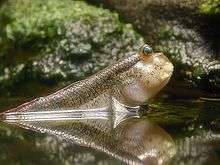Periophthalmodon septemradiatus
Periophthalmodon septemradiatus is a species of mudskipper found along tropical shorelines of the eastern Indian Ocean where it occurs in marine, brackish and fresh waters from India to Indonesia. It is found along in estuaries as well as in the rivers.
| Periophthalmodon septemradiatus | |
|---|---|
 | |
| Scientific classification | |
| Kingdom: | Animalia |
| Phylum: | Chordata |
| Class: | Actinopterygii |
| Order: | Gobiiformes |
| Family: | Oxudercidae |
| Genus: | Periophthalmodon |
| Species: | P. septemradiatus |
| Binomial name | |
| Periophthalmodon septemradiatus (Hamilton, 1822) | |
| Synonyms[2] | |
| |
This species inhabits mud banks which are covered by such vegetation as mangroves, nypah palms where the water is of very low salinity, near 0 ppt, in the upper reaches of estuaries and in small tributaries.[3] It can grow to a length of 10 centimetres (3.9 in) TL.
This species is of no interest to local commercial fisheries.[2] The specific name means "seven rayed" and refers to the seven short rays in this fish's first dorsal fin.[4]
P. septemradiatus is the only fish known to communicate acoustically while out of water and when they are alarmed they dash towards land rather than water.[3]
References
- Jaafar, Z. (2019). "Periophthalmodon septemradiatus". IUCN Red List of Threatened Species. 2019: e.T128706414A128706432. Retrieved 10 June 2020.
- Froese, Rainer and Pauly, Daniel, eds. (2018). "Periophthalmodon septemradiatus" in FishBase. June 2018 version.
- "Gobidae: Oxudercinae Periophthalmodon septemradiatus (Hamilton 1822". Mudskippers. Retrieved 13 August 2018.
- Christopher Scharpf; Kenneth J. Lazara (24 July 2018). "Order GOBIIFORMES: Family OXUDERCIDAE (p-z)". The ETYFish Project Fish Name Etymology Database. Christopher Scharpf and Kenneth J. Lazara. Retrieved 13 August 2018.
